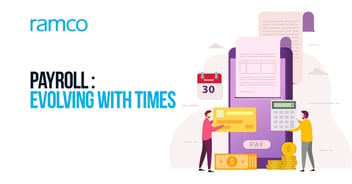
Finance and hence, Payroll software must understand the time value of money. Payroll software is not an investor but it does handle the payroll dollars, a sum that can be 60% or more of all factor costs in a business. Given the international nature of business, it must understand time zones, local legislation, currencies and industry - business norms to even make a basic entry. We can all agree that this is a tall demand. No guises here, the entry barriers are fairly steep.
Manufacturers have added to this complexity, using payroll to drive employee behavior and hence business outcomes. Matching incentives to outcomes allows manufacturers to ensure machines are properly tooled and the right products are produced in the production line. Compare this to an erstwhile minimum wage or festival advance pay. The workers are empowered and incented to produce as per target. Ignoring targets goes against their interests as they could lose out on the incentives. In the services business, intangibles such as customer service have to be tracked and tied to incentives.
Employees in turn, by virtue of their life events, add to this complexity. An employee who has taken a loan (whose recovery is facilitated through payroll) could request that the monthly deductions be deferred.
It doesn’t stop here. Payrolls are typically run weekly or bi-weekly, monthly etc. depending on the legislative zone and class of workers. Security (access) is also set up along those lines.
Broadly the objects in a typical payroll software include entities and handles. Entities are those that feed or consume information. Handles permit payroll users work with payroll information, enforcing actions where needed (compliance) and providing flex where permitted.
For instance, employee driven changes to monthly payroll are considered "time-critical” payroll advices that need handling at the time of payroll process, affecting entities such as pay elements (a deduction element from the gross). This is an example of the flex.
Tax deductions, again pay elements (entities) are “time sensitive”. A formulaic approach, one that is called upon for execution at payroll run time, acts as a necessary and sufficient handle – even when bonuses or arrears are paid as the tax elements know how to handle the extra monies in advance.
Time dependency is also a quality of Payroll. Pay elements must be tied to employee time sheets through formulae (business rules that spell policy).
Further, payroll security is set by the value. Management payroll is usually separate from worker payroll and handled by a person with authority. Payroll process is set by volume. How many records must be in process at any time? This is a parameter that can be set by the populace to be handled, the similarity (in pay) thereof and time to process expectations.
Imagine a payroll administrator who has to handle 50% exception advices from an employee base of 10,000 employees. Other payroll entities that necessitate handles are spending accounts, garnishments, and accumulators. These can potentially receive their inputs (advices) from a variety of channels including employee self-service and third party systems. This opens the door for further blogging about payroll software and services. Watch this space…
Frequently Asked Questions (FAQs)
Enterprise asset management (EAM) involves the management of mission critical assets of an organization throughout each asset's lifecycle. EAM is used to plan, optimize, execute, and track the needed maintenance activities with the associated priorities, skills, materials, tools, and information. The aim is to optimize the quality and utilization of assets throughout their lifecycle, increase productive uptime and reduce operational costs.
Enterprise asset management (EAM) involves the management of the maintenance of physical assets of an organization throughout each asset's lifecycle. EAM is used to plan, optimize, execute, and track the needed maintenance activities with the associated priorities, skills, materials, tools, and information.
The software helps in effective maintenance of assets through preventive, predictive, shutdown and breakdown maintenance strategies. The system also helps enterprises mitigate equipment risks by enhanced safety standards. The streamlined operations and improved asset performance helps organizations increase their investment effectiveness.
EAM is important because it helps organizations track, assess, manage and optimize asset quality and reliability. Asset intensive Organizations have hundreds, thousands, even millions of assets which needs to be maintained to maximize / optimize life of these assets to increase the return on investment.
The key features of effective EAM are:
- Work management.
- Maintenance Strategies (Preventive/ Predictive / Breakdown / Shutdown).
- Planning and scheduling.
- Supply chain management.
- Health and safety.
- Mobility.
- Analytics.
- Improved Asset Health at reduced cost through data driven maintenance Programs
- Complete visibilityon entire maintenance data across Equipment, across Models, across Branches to aid in analysis & decision making such as to Repair or Replace the Equipment
- Insightful analysis of Inspection Data to improve customer satisfaction
- Effective maintenance management enhanced by predictive maintenance and inbuilt analytics
- Increased reliability and safety, keeps complete track of all the inspections & calibration schedules
- Mobile Application enables users to execute work while “in the field” leading to minimized non-productive time and increased productivity and reduces duplication of work and human errors in recording information.
- Quick turnaround time through Actionable Notification & Alerts for every process in real time and accessible anytime and anywhere.
- Improved Regulatory Part of asset management involves the implementation of better O&M practices, which can significantly improve compliance.
Asset Intensive companies under the following Industries :
- Ports
- Cement and Mining
- Utilities
- Fleet Maintenance
- Equipment Rental
- Other Manufacturing
- Real Estate & Infrastructure
- Power Generation
Contact us for a meeting and schedule a demo
This differs on case to case basis, based on the type of installation and unique industry specific requirements. Contact us for a meeting and schedule a demo.
This differs on case to case basis, based on the type of installation and unique industry specific requirements. Contact us for a meeting and schedule a demo.
Stay Connected, follow us on LinkedIn / Twitter to know more about EAM Software latest trends.


